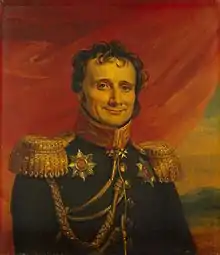Summary of the Art of War
Summary of the Art of War: the Principal Combinations of Strategy, Grand Tactics, and Military Politics (French: Précis de l’Art de la Guerre: Des Principales Cominaisons de la Stratégie, de la Grande Tactique et de la Politique) is a military treatise by Antoine-Henri Jomini, originally published as a complete work in 1838.[1] The work, which lays out Jomini's theory of war, includes a series of maxims that were extensively taught and discussed at the United States Military Academy.
| Author | Antoine-Henri Jomini |
|---|---|
| Original title | Précis de l’Art de la Guerre: Des Principales Cominaisons de la Stratégie, de la Grande Tactique et de la Politique |
| Subject | War |
Publication date | 1830 |

Content
Summary of the Art of War focuses on war policy and "the problems of adapting military means to political objectives".[2] Jomini implied both the diplomatic and military importance of territory (for example as necessary to raising manpower as well as resources needed for maintenance of an army).[3] However, he did not make territory the target of military operations, seeing the defeat of the enemy army as the "only effective means of accomplishing a war of invasion".[2] The work is perhaps known for its maxims that explained a principle he believed underlies all war :
- "To throw by strategic movements the mass of an army, successively, upon the decisive points of a theater of war, and also upon the communications of the enemy as much as possible without compromising one's own."[4]
- "To maneuver to engage fractions of the hostile army with the bulk of one's forces."[4]
- "On the battlefield, to throw the mass of the forces upon the decisive point, or upon the portion of the hostile line which it is of the first importance to overthrow."[4]
- "To so arrange that these masses shall not only be thrown upon the decisive point but that they shall engage at the proper times and with energy."[4]
Legacy
It is considered Jominis' greatest work; the historian Mark T. Calhoun has called it Jomini's "capstone", and Robert B. Marks of Legacy Books Press has referred to it as the author's "magnum opus".[5][6] Used extensively at West Point, it gave birth to the saying "that many a Civil War general went into battle with a sword in one hand and Jomini's Summary of the Art of War in the other".[7]
References
- Alger, 1975, pp. 18, 30.
- Jones, 1970, p. 128.
- Jones, 1970, pp. 127-131.
- Jomini as quoted in Calhoun, 2011, pp. 27–28.
- Calhoun, 2011, p. 25.
- de Jomini, 2008, p. v.
- Harsh, 1974, p. 133.
Bibliography
- Alger, John I. (1975). Antoine-Henri Jomini: A Bibliographical Survey (PDF). United States Military Academy Library Occasional Papers. West Point, New York: United States Military Academy. Retrieved February 22, 2023.
- Calhoun, Mark T. (2011). "Clausewitz and Jomini: Contrasting Intellectual Frameworks in Military Theory". Army History. U.S. Army Center of Military History (80): 27–28. ISSN 1546-5330. JSTOR 26296157.
 This article incorporates text from this source, which is in the public domain.
This article incorporates text from this source, which is in the public domain. - Jomini, Antoine-Henri (2008). The Art of War a.k.a The Summary of the Art of War. Ontario, Canada: Legacy Books Press. ISBN 9780978465247.
- Jones, Archer (1970). "Jomini and the Strategy of the American Civil War, A Reinterpretation". Military Affairs. 34 (4): 127–131. doi:10.2307/1986781. ISSN 0026-3931. JSTOR 1986781.
- Harsh, Joseph L. (1974). "Battlesword and Rapier: Clausewitz, Jomini, and the American Civil War". Military Affairs. 38 (4): 133–138. doi:10.2307/1986536. ISSN 0026-3931. JSTOR 1986536.